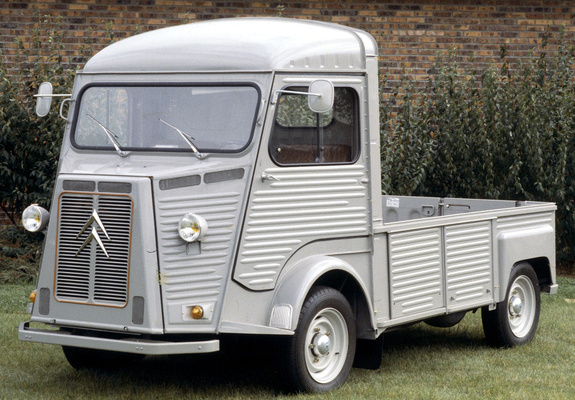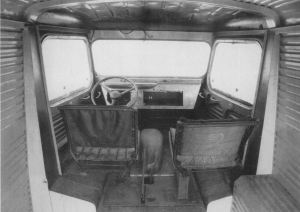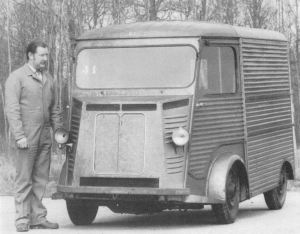Translate This Page
Citroen H Van History
It was initially conceived around 1943 as a light weight, high capacity front wheel driven van that was full of innovation.
At a time when commercial vehicles, and indeed most saloon cars of the day, were built using a separate, heavy, cart sprung chassis and a bolt on body, the Type H was the first mass produced Van to utilise monocoque construction where the body and chassis were designed as an integrated unit.
Nothing else in the class was as light or so strong.
If this was the HY's only claim to fame it would have been more capable than most, yet this was only the start of the Citroen H vans onslaught on the Commercial market. It boasted an ultra low floor, 3 piece rear door, Front wheel drive, Torsion Bar suspension, Rack and Pinion steering, a very advanced braking system that was powerful but complex, 6' standing height and a side loading door. Also unusual for it's day was a large 1.9 litre engine, when other commercials of the era had much smaller less powerful engines. The VW T1 transporter of 1953 has an engine of just 1.2 litres limiting it's useful payload.
It would be almost 40 years before front wheel drive, rack and pinion steering and side loading doors became the standard in the UK. We know of no other Commercial vehicle that took such a leap into the future. It is therefore not surprising it was in production from 1949 to 1981, with over 470,000 vehicles built in 3 different countries.
On introduction in 1949 the van had a designation of Citroen Type H. This was soon replaced by the designation Type HY and HZ. Most of the surviving vehicles are Type HY's and this is by far the more common name associated with the vehicle. We make no apology for referring to them as Citroen HY vans.
The book Les Types H de collection by Patrick Lesueur, lists the 1949 11cv H van as being capable of 78kph (47MPH) with it's 4 cylinder 1,911cc, 35 bhp engine.
Although a small number of HY's were assembled at Slough, in right hand drive form, the majority were built in France and the Nederlands. There are rumours of a single Slough survivor with Right Hand Drive.
Technical
The all Cast Iron 1,911cc engine and many smaller parts are derived from the Citroën Traction models, see :-.
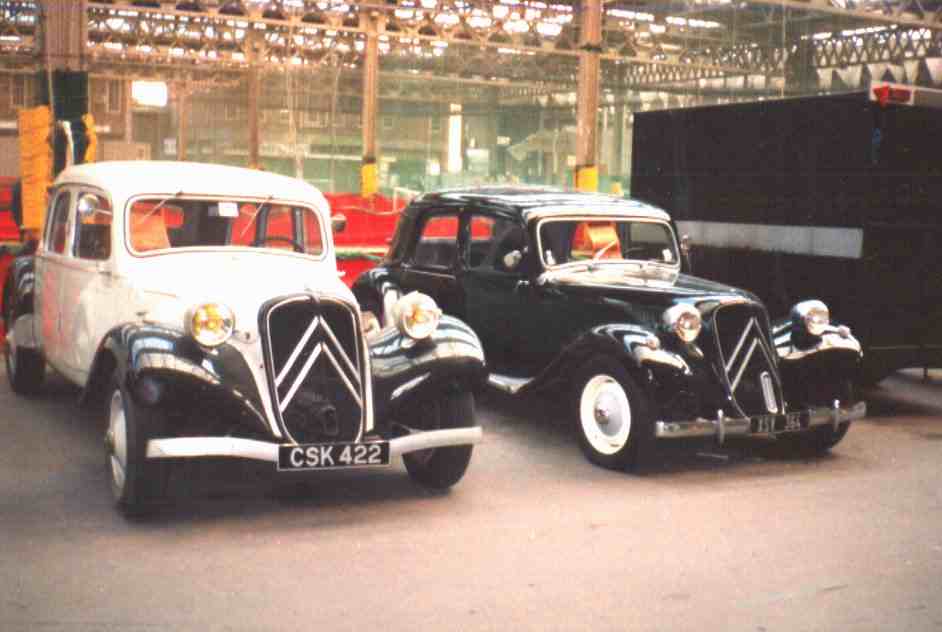
The early petrol (Essence) engine and 3 speed gearbox are closely related to that in the Traction Avant, see photos above. However the installation in the Type H had the engine mounted at the front with the gearbox behind. The Traction layout placed the gearbox at the front with the engine behind it. If you look closely at the photo above you can see the shadow of the Gearbox behind the Radiator in the white Car, CSK 422.
As a result the engine in the Traction rotates in the other direction. When the Traction engine found it's way into the first of the Citroen DS cars it was very much the Traction layout but with a 4 speed Gearbox that was not renowned for it's strength. The Citroen DS engine was quickly improved and this derivative found it's way into the HY vans of 1963.
While three different diesel (Fuel) engines were available, the bulk of sales were petrol engines of 1,911cc or 1,628cc as the Diesels of the 1960's were pretty dreadful.
Both petrol engines shared the same 100mm stroke but different bores of 78mm or 72mm which gave the vans the designation of either HY78 or HY72. The later Diesels used a model designation of HYIN (for INdenor).
The petrol engine underwent a host of minor revisions during it's 34 year production run, like in 1960 when it received shell bigend bearings to replace the White Metal type. The Cylinder block was also changed around the same time in preparation for an improved water Pump for the revised Aluminium Cross Flow Cylinder Head that would arrive a few years later in 1963. This 'intermediate' Cast Iron Head engine, of which we have only seen three, also had an Alloy sump.
All engines are robust, but the petrol engines were not equipped with an Oil filter, so the frequency of the oil changes tended to dictate engine life to a greater degree than other engines of the period. But despite this omission, mileages in excess of 100,000 were possible if the SAE30 Oil was changed regularly. Oil changes at least every 2,500 kilometres are essential for reliable running.
The van might not have looked it but in 1949 this was a truly modern design. Clever construction techniques, like the use of omega profiles (multiple thin plates welded together for strength without weight) corrugated side panelling, the ultra strong two piece welded floor that would take the weight of a horse and the innovative door hinges.
While the engines were relatively simple by todays standards, they were well ahead of the UK's offerings of the day. Most UK vans of the period were still using side valve engines with the bore engineered into the soft Cast Iron block that deteriorated very quickly. The HY had removable harder cylinder liners and overhead valves. Some rivals were still using the cylinder bore cut into the Cast Iron Block until the eighties!! For example compare it to possibly the closest UK rival, the Morris J type, photo below.
Introduced around 1949 with a 1,476cc side valve engine with soft iron bores, the Morris J had rear wheel drive using a separate chassis and body. Load capacity was around 500kg and about half the volume of the H van, although it cost slightly less.

While looking cute, the British built Morris J was not in the same technical league. Production ceased in 1961, 20 years earlier than the H van, they are now very, very rare.
The Volkswagen Transporter was introduced 3 years after the Citroen H van and copied some of its best characteristics, like the Torsion bar suspension and the removal of the engine and gearbox as a single unit (exhaust and ancillaries attached) by removing very few bolts. Yet by comparison the interior was cramped and slow with its puny 1,100cc engine (later 1200cc) being unable to carry a very big load which was less than half the Citroen H van's with it's bigger 1,911cc engine.
While the Transporter had half the load volume and weight of the H van, it's over all length was very similar.
The Citroen H Van engine was designed to make servicing and repairs cheap and quick.
In an age when complete brake failure was not uncommon to have the hand/emergency brake operate on the front wheels was very effective and reassuring, yet almost unique to Citroen.
At the rear the torsion bar suspension and lack of drive to the rear wheels gave a very low floor that was accessed through a 3 piece door. The upper door opened skywards to above head height to give some shelter when loading/unloading and also allowed longer items to be carried safely as the lower doors could be kept closed to keep contents safe. The 2 lower doors hinged on the van sides and opened outwards.
The cab doors hinged at the rear edge, 'Suicide' style, and opened to a very high seat with a commanding view. Dutch built vans had the driver and passenger doors hinged at the front. These made getting in and out of the van difficult so the step was built up with a higher 'platform'. The very 'fat' front steps are the most notable giveaway of a Dutch built van.
The distinctive corrugated body work was very strong, yet lighter in weight than anything else of the size. The load capacity was also ahead of the competition, at 1600kg, exceptional for a vehicle that only weighed 1,200 kg.
The handling and roadholding was also outstanding. The Torsion bar suspension, low centre of gravity along with the front wheel drive and low weight all contributed to fast, safe corning that even today is classed as good.
Timeline
1947 Type H 11cv announced with a 35bhp @ 3,500rpm, 1,911cc motor, had a Cast Iron head with Inlet and Exhaust manifold on the same side, i.e. not Crossflow. Compression ratio was 6.8:1. Top speed was only 78kph/47mph.
Lighting wasn't perfect as the electrics were 6volt via a Dynamo, just like the VW transporters of the time. Also like its VW rival, it had a 'split' two piece windscreen, which lasted on the Citroen up until 1964.
|
In 1949 came the cheaper HZ with a lower maximum payload of 850kg but a higher top speed of 88 kph (51mph). Typical fuel consumption was 13 litres per 100Km (about 20MPG). Around 1957/58 the Hand brake changed from a Hockey Stick arrangement operating on the rear wheels to a reverse handbrake solution operating on the Front Wheels. The handbrake operation on the front wheels catches out a lot of Garages who spend hours trying to pull off the Front brake drums with the handbrake applied. If you have a Hockey stick style of handbrake take great care when moving to the back of the van as it is easily knocked off, accidentally releasing the Brakes. In 1958 the H was superseded by the HY with a maximum payload of 1,500kg. Around this time engine power had risen to about 42bhp at about 4,000rpm. There were several minor modifications to Carburettor and ignition timing from 1947 up to the mid fifties as fuel quality improved so did the power output, peaking at about 45bhp at 4,200rpm by the time the cast Iron Head engine was superseded by the Crossflow alloy head version in 1963. Top speed of a early 1960's Cast Iron Head engine had risen from the 47mph at launch in 1947 to about 54mph in a Standard Van by 1960. A Horse box with high Roof and greater weight might struggle to better 40mph though.
In 1961, the HY DI and HZ DI were launched, fitted with a four cylinder Perkins diesel engine of 1,621cc capacity developing 42 bhp @ 3,600 rpm and rated at 7 CV. The six volt electrical system was replaced by a 12 volt one, still via a Dynamo, across the range. Some time around this period the front Torsion Bars increased in size, becoming longer and the Engine Mounting 'Cushions' also changed significantly from 'springs' to Rubber in compression. At the end of 1963, the 1,911cc engine received an Alloy cross flow head, developing more power. A new Alloy head 1,628cc version of the same engine with narrower 72mm cylinder liners was also introduced, called the HY-72 and HZ-72. This 1,628cc petrol engine developed 45 bhp @ 4,200 rpm and was more powerful than the 1962 1,911cc Cast Iron Head engine. Top speed was close to 58mph. Both of the 'new' engines had a 7.5:1 compression ratio. Brake Drums increased in size being almost a 1/3rd wider on the front. Rears remained the same but gained larger bore Slave Cylinders and a Brake Compensation valve. In 1964, a single windscreen was fitted to all models. Wiper motor updated and the 12v Dynamo replaced by a 12v Alternators across all Petrol models. The Perkins 1,621cc diesel was replaced by an Indénor engine of 1,816cc capacity developing 50 bhp @ 4,000 rpm. These models were called HY-IN and HZ-IN. In 1966, the HY 78 and HZ 78 were launched, fitted with an improved 1,911cc petrol engine developing 58bhp @ 4,100 rpm, and a 1,600kg payload. Around this time, through developments in the engines, improved fuel quality plus a higher ratio gearbox on the HY78 and even higher on the HZ78, petrol consumption had improved to about 11 litres per 100 km (about 23MPG) and top speed was up to 101kph/63mph. Around the same time the already strong Gearbox was redesigned as a stronger unit with better syncromesh and a new Clutch disc. New driveshafts were also employed. The Indenor Diesel engine grew to 1,948cc developing 56bhp @4,000 rpm but even in it's largest guise torque was poor, only 83 ft/lbs @ 2,250rpm as opposed to the 1,911cc Petrols 101 ft/lbs @ 1.750 rpm. Fuel economy was only marginally better than the petrol versions. All the Diesel engined versions were badly lacking in power with less torque than we expect today The 1,621cc Perkins Diesel and 1,816cc Diesel were especially poor having less torque than the 1600cc Petrol. The main attraction of Diesel power in France over petrol in the 1960's was not the improvement in MPG we expect today, but the lower cost of 'Fuel' at the pumps by almost 19%. In the late 1960's a road tester of the Peugeot 404, which was available with both a petrol and the Indenor Diesel, noted there was little difference in fuel economy. He wrote, "the diesel Peugeot settlies down to a stolid 60 m.p.h. cruising speed which I found rather charming. In the UK, where diesel oil costs more than 5 shillings a gallon (25p in today's money), the increased economy is not pronounced". However, despite this cost saving in fuel in it's Home Country, the petrol engined vehicles outsold the Diesel engined versions by a big margin. Advanced as it was in it's day, the Indenor Diesel engine was slow, smelly and very noisey. It was not liked by its drivers. In the UK the gap between the cost of Petrol and Diesel was less so the financial savings did not make up for a Diesel Car/Vans disadvantages. As a result few Diesel engined cars or vans were bought in the UK until the late 1980's. Many garage forecourts sold only Petrol with only the bigger Lorry friendly garages having a Diesel pump. Having a Diesel engined car/van in the 1970's meant you queued up with the Lorries. During 1966 a motorist in the UK would have paid 24p (about 5 shillings in pre decilimisation money) for a Gallon of Petrol. Diesel was generally around 21p but often hard to find. Thank you to the AA for this PDF below which shows not only the overrall cost of fuel, it also shows the Taxation applied, which although not directly related to this page, makes interesting reading : |

|
AA Petrol_Prices_1896_2012_gallons.pdf Size : 52.882 Kb Type : pdf |
In 1969, a new model, the HX IN2 was launched with a fully laden weight of 3,100kg, increased to 3,200kg in 1969 when it was called HW IN2. Also in 1969, the vehicle was given a minor facelift with rectangular rear wheel arches, new front indicators and just two instead of four shock absorbers at the front.
The Diesel Indenor installation in HY vans was slow, crude and noisey but reliable.
Around 1973 a Dual braking Circuit system was available.
Contrary to what you might read, numerous mechanical changes were made throughout the models 34 years run from Gear change mechanism to brakes, exhausts to Wipers, Seats to Shock Absorbers, Dashboards to Drum brakes, Drive shafts to Speedo, etc.
There are four variations on Brake pipes sizes and layouts. The rear Brake slave Cylinders are available in 19mm, 23.5mm and 28mm.
While the overall body shape might not have appeared to change much, it also underwent many changes.
The change from Semiphore Indicators meant a change to the Body panel behind the Cab Doors. The Cab doors themselves went through at least four changes due to improved Locks and different shaped Flutes to accomodate new Mirror mountings. The wheel arches changed, Rear Door window altered in size. The Nose Cone side panels went through 3 variations, primarily with different lower light mountings. The windscreen.
The roof of the Nose Cone changed from fluted to pressed square panels. The rear end changed twice, before gaining a rear bumper when the rear jacking points also moved to the sides.
The front hinged Bonnet changed during the early sixties to accomodate a Heater duct when a Heater became an almost standard fitment. There are four different heaters that we have seen. The Bumpers changed. The Rear lights changed, etc
When buying replacement parts check what you are buying will fit, don't assume it will be the same.
Also note that over the years an early van may have been 'improved' by the adoption of the later bigger brakes, stronger/bigger front Torsion Bars/Tubes, later gearbox, later Engine, 12v electrics, etc.
The Following is courtesy of CitroNetThe Citroen G, 'baby H' Van or 2CV H |
|||
|
In 1948, a smaller version of the H van was suggested, powered by a flat twin. But the G never went into production. |
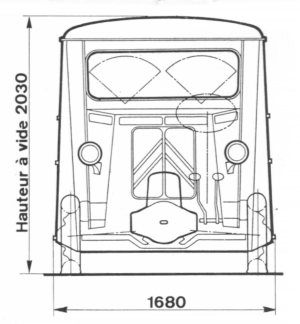 | ||
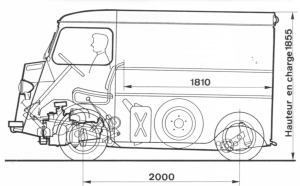 |
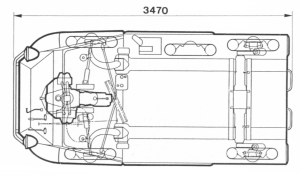 | ||
|
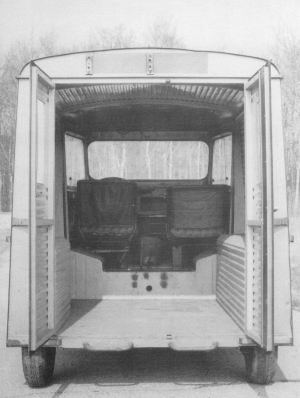 | ||
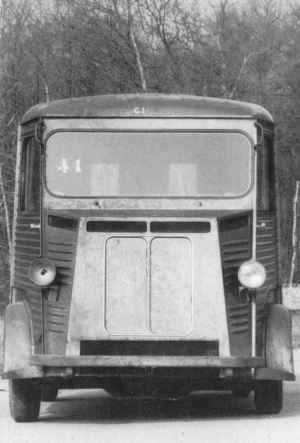 |
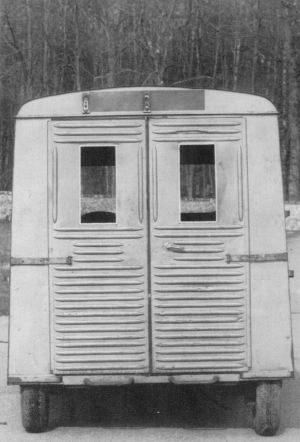 | ||
|
|
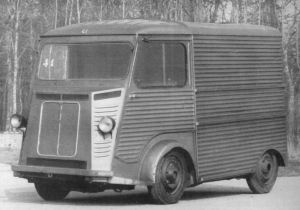 |
Citroen H van, 2000 interpretation?

